Beautiful Kokeshi Dolls: A Uniquely Japanese Folk Art

|
||
| Licensing | ||
Take a fresh look at the traditional and iconic Japanese kokeshi folk toy by exploring its origins and history. This collection of photographs documents pieces from the extensive private collection of Itske and Anthony Stern. The photos and accompanying text were presented during a public program, Kokeshi: Not Just a Toy!, at the Japanese American National Museum on July 25, 2009 in conjunction with the Kokeshi: From Folk Art to Art Toy exhibition on display from July 11 through October 4, 2009. Collector Itske Stern, author of articles about kokeshi for Daruma magazine and other Japanese publications, and her husband Anthony, talked about the history of traditional kokeshi and their personal journey in collecting over 1,200 of these beautiful folk toys. To learn more about the exhibition, please visit the exhibition website: janm.org/exhibits/kokeshi
Slides in this album |
|

|
BEAUTIFUL KOKESHI DOLLSA UNIQUELY JAPANESE FOLK ART
Kokeshi dolls |
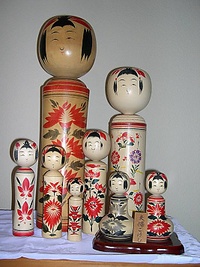
|
Naruko DollsNaruko kokeshi are distinguished by their sharp shoulders and a head that, when turned, makes a squeaking sound. This is the only doll that does so. Some of the newer ones have rounded shoulders like the one on the left of the screen.
Naruko Dolls |

|
Kijiyama DollsKijiyama dolls are made from one piece of wood and have a very distinctive pattern of kimono and obi.
Kijiyama Dolls |
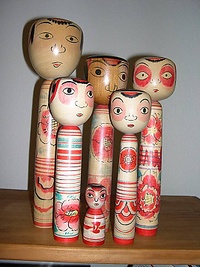
|
Nakanosawa DollsNakanosawa dolls are very distinctive dolls due to their atypical Japanese eyes surrounded by large, pink rims. This doll was made in tribute to a street entertainer who walked on his hands with a pillow between his knees and had make up similar to the faces of these dolls. After …
Nakanosawa Dolls |
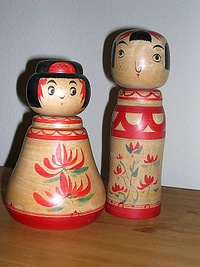
|
Zao - Bikkuri Me Dolls (Surprised Eyes)These are from the Zao- Shiroishi onsen (hot springs) and have the characteristic surprised eyes. Very cute. |

|
Tsuchiyu DollsTsuchiyu dolls are easily identified by their long, tubular, round shouldered shape and especially by the striped pattern on their body. The heads have a “bull’s eye” circular pattern. This will be explained later. The largest doll in the photo is the only one with two camellias on it , …
Tsuchiyu Dolls |
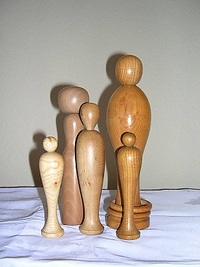
|
Nambu-Hanamaki DollsThese dolls are characteristic of the Nambu area, lacking any design or painted color. The largest one here has two rings around the base and the doll and rings were made all from one piece of wood. The head is often loose. |

|
Sakunami Dolls*Sakunami Kokeshi Dolls
Sakunami Dolls |
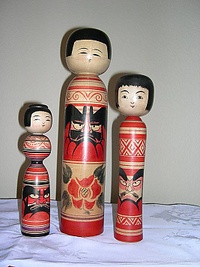
|
Tsugaru DollsThese lovely dolls are distinguished by the Daruma pattern painted on them with stripes and camellias. I asked one of the dollmakers why the scary daruma was painted on it and he said it was to keep evil spirits away from children. These dolls also have a “bust” and waist. …
Tsugaru Dolls |

|
Togatta DollsThe dolls from Togatta are recognized by the very distinctive head design with the red petals along the sides of the heads. There are many different designs painted on the bodies ranging from diagonal red stripes, flowers kimono collars, and more.
Tohgatta Dolls |

|
Hijiori DollsThese very distinctive dolls have a very heavy hairline and “sanpaku” eyes (three line eyes). Made only by a handful of dollmakers they tend to be more expensive than most kokeshi dolls because there are so few makers of this style.
Hijiori Dolls |
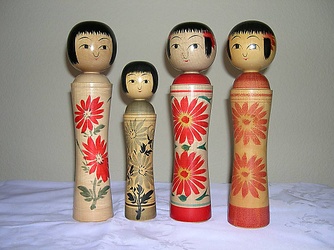
|
Oshin (Naruko) DollsOshin dolls are designed after the Naruko doll with their distinctive shoulders. These pretty ladies were made after a very popular serialized telvision program featuring “Oshin,” a poor woman who overcomes hardships to make a better life. When the program was finished, its popularity among the Asian community created the … |
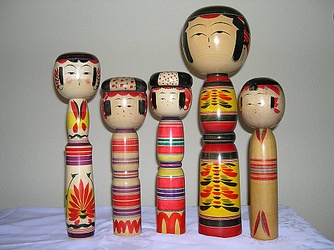
|
Yajiro DollsYajiro dolls are easily recognizable by their signature waistline and colors. This doll has a dominant yellow base for its body with purple, black, blue and red designs. The various patterns range from stripes to flowers. Some of these dolls also have a topknot hairdo.
Yajiro Dolls |
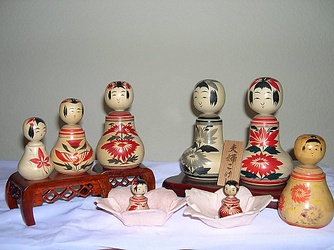
|
Naruko Nemoriko DollsNaruko “sitting” dolls are called nemoriko dolls, indicated by the kimono spreading around the sitting person. Other strains of kokeshi also have the nemoriko style. |

|
Ejiko DollsDon’t overlook these babies!!! These are the babies in the “baskets” (EJIKO) and this is how the field workers took their babies to work with them, by placing them in baskets near them as they worked. All the ten different types have these ejiko dolls.
Ejiko Dolls |
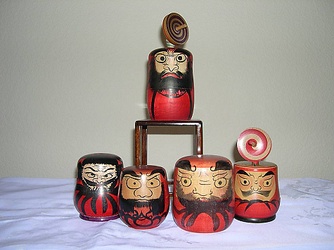
|
DarumaThese wonderful little men are also made by kokeshi makers and some are made as toys. The daruma legend came from India and it is about a man who sat on a wall and worried about the problems of the world. He lost his legs from non use and his …
Daruma |
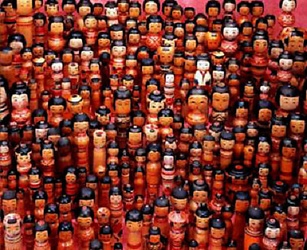
|
Kokeshi dolls |
 ylkawashima
ylkawashima
 2009 Tanabata Festival
2009 Tanabata Festival Tanabata at JANM 2009
Tanabata at JANM 2009 Beautiful Kokeshi Dolls: A Uniquely Japanese Folk Art
Beautiful Kokeshi Dolls: A Uniquely Japanese Folk Art How to Make Your Own Tanabata Decoration
How to Make Your Own Tanabata Decoration Simple Kokeshi Doll Tutorial
Simple Kokeshi Doll Tutorial Bridging Generations: The UCLA Nikkei Student Union
Bridging Generations: The UCLA Nikkei Student Union
 Journal feed
Journal feed
